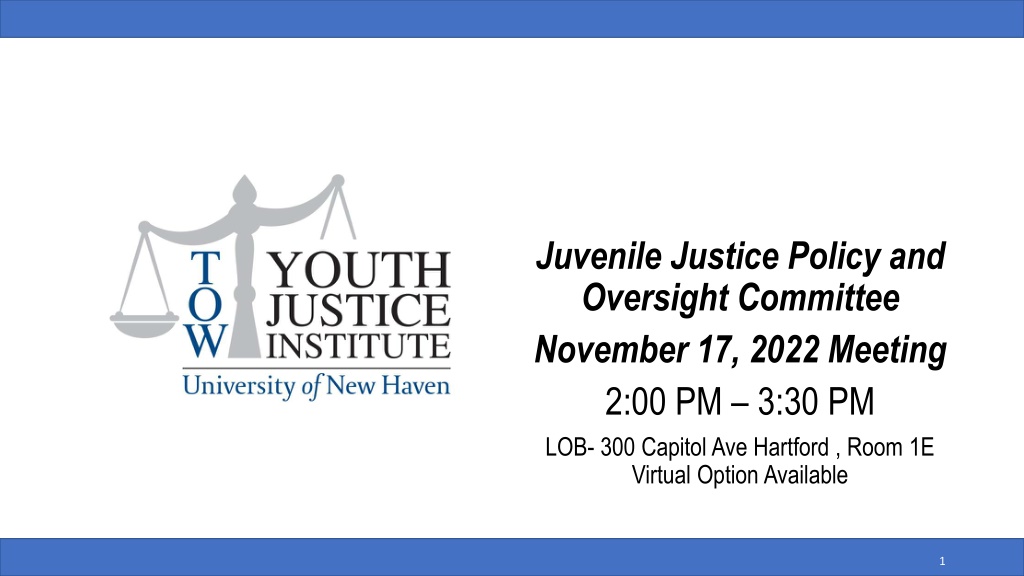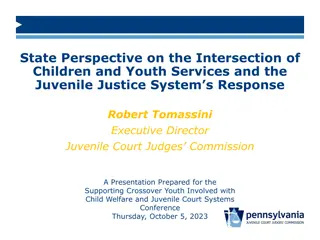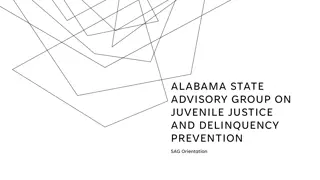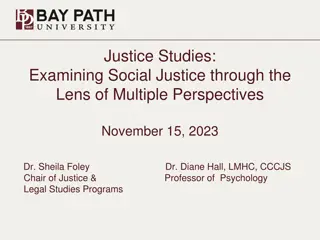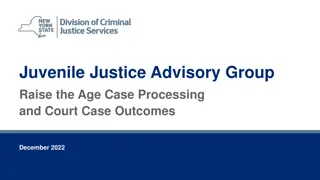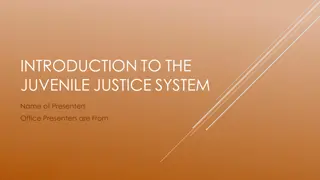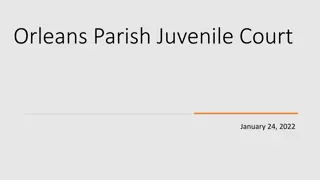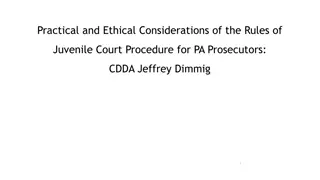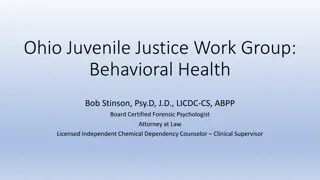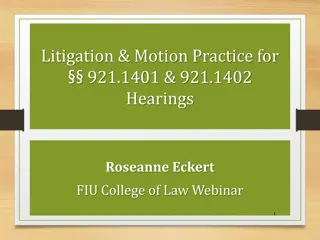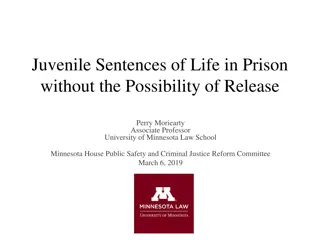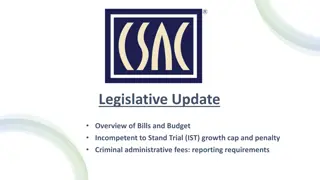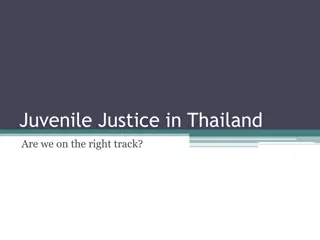Aligning Group Care to Meet Needs in Juvenile Justice: Strategies and Recommendations
The Juvenile Justice Policy and Oversight Committee meeting on November 17, 2022, focuses on aligning group care to meet the complex needs of children in the system. The agenda includes reports from various departments, historical context, challenges, strategies, interventions, and results in ensuring the well-being of children in foster care. Recommendations highlight investing in evidence-based practices and seeking regional services to address mental health and medical needs effectively.
Download Presentation

Please find below an Image/Link to download the presentation.
The content on the website is provided AS IS for your information and personal use only. It may not be sold, licensed, or shared on other websites without obtaining consent from the author. Download presentation by click this link. If you encounter any issues during the download, it is possible that the publisher has removed the file from their server.
E N D
Presentation Transcript
Juvenile Justice Policy and Oversight Committee November 17, 2022 Meeting 2:00 PM 3:30 PM LOB- 300 Capitol Ave Hartford , Room 1E Virtual Option Available 1
Opening Remarks Welcome and Introductions - Rep Toni Walker and Under Sec. Marc Pelka Approval of October 2022 Meeting Minutes 2
Meeting Agenda Department of Children and Families Respite Beds Warden Michael Pierce, Department of Corrections DOC Report out on PA 19-187 Catherine Foley Geib, Judicial Branch Court Support Services Division JBCSSD Report out on PA 19-187 Erika Nowakowski, Tow Youth Justice Institute JJPOC Recommendation & Report Timeline 3
CT Department of CT Department of Children and Families Children and Families Aligning Group Care to Need Vannessa Dorantes, LMSW, Commissioner commissioner.dcf@ct.gov Michael Williams, MSW, Deputy Commissioner Michael.Williams@ct.gov
Historical Context Nov 2022 3,087 total minus 335 >18yrs old = 2,752 CIP Jan 20114,770 total children in DCF placement Jan 2019 4,311 total children in DCF care 51% are in kinship settings 21% in kinship settings 40% in kinship settings, 8.9% in Independent Living 3% in independent living 6% in Independent Living 6.2% in Congregate Care (187) 5 out of state 32% were living in *Group Care 7.5% in Congregate Care (325) 363 out of state 8 out of state March 2020 COVID 19 PANDEMIC 2018 CJTS closed Aligning Group Care to Need
How we got here? Group Care type Current challenges Intended purpose Strategies Intervention Result What s in a name? Problem we tried to solve What did we do? Unintended consequences? What else can we try ? Did it work? Aligning Group Care to Need
Alignment activities Group Care Type Purpose Alignment intervention Result Current Challenges Strategies Children in foster care with mental health needs that exceeded the treatment capacity of CT programs. Invested in EBPs Intensive In-Home Services, IICAPS,MDFT, FFT The need for OOS PRT reduced from 300+ to 5. Need treatment services for severely medically/ psychiatrically challenged youth Continue to seek regional/national services because of the unique needs --very rare -- require Cmsr approval Out of state psychiatric residential treatment Invested in CT Residential programs, i.e. specialty pops PSBs Provide diagnostic assessments of all foster care entries prior to any placements Eliminate program and invest in FAST/CST to provide transitional services in foster/kin homes at the time of placement. Closure of all SAFE HOMES SAFE HOMES Invested in SFITS Increased kinship care rates Developed to be a level of care for children in foster care whose mental health needs don t require residential treatment but cannot be met in a therapeutic foster home. Increased investments in therapeutic wrap around services for kinship and core foster homes. Youth in foster care experienced better outcomes in families and preferred to live with kin/relatives instead of group care. Older youth in foster care widely rejected group care placements. Group home utilization rates plummeted to less than 40% resulting in inventory reduction of 50%. Continue exploring alternative proposals to serve DCF involved families with surplus capacity/inventory. Group Homes (Therapeutic) Low utilization of current reduced group home capacity. Shifted resources from group care to family care.
Alignment activities Alignment intervention Group Care Type Purpose Result Current Challenges Strategies Short-Term Assessment/Respite STAR Group care placement for difficult to place foster youth 13-18 years old who present with very challenging behaviors; i.e. runaways, delinquency, etc) Invested in facilities to serve each region for boys and girls in foster care. Invested in enhancing the quality-of-care youth receive when placed in a STAR. Utilization is very high in these settings and prompted the need to expand capacity increasing the inventory by one additional STAR home. The need continues to exceed capacity and one additional STAR facility is needed for youth in foster care. Seek resources to invest in an additional STAR program. This service type is licensed as a temporary shelter. They are not ligature free. The service was a transformation from other temporary shelter settings (from Safe home settings-for 1 time removals and one stabilization site). In 2020 and 2019 utilization was 30% of 70 beds. Also in 2021, it started at 30 % and began to decline throughout the year. The homes had lower utilization annually prior to 2019. Referrals to SFITs were historically low from the beginning. When we surveyed our teams SFITs were described as a 'catch all' for OTCs, emergency placements, day time stays for youth, and some planned stays to prevent disruption. There were reports that some providers would take youth in need of a different level of care until the youth moved to another level. Less than 20% utilization since the program s inception. SFITS Reprocured SFIT services/dollars for Crisis Stabilization services supporting Urgent Crisis Centers. Beacon Health Options managed the LOC determination and matching, and providers made direct referrals also. On Friday there were 13 youth in remaining SFit slots. The number fluctuates daily. Intended to be no more than a 2week stay to return home Eligibility for this level of care is for all youth regardless of DCF status.
Group Care Type Purpose Alignment intervention Result Current Challenges Strategies UCC/SAC The Sub-Acute Crisis Stabilization (SACS) applicant will serve youth experiencing behavioral health crises and are responsible for de- escalating and stabilizing the youth/young adult, completing a comprehensive diagnostic assessment (screening and assessment results from the referring party may be used as relevant), developing a treatment plan, providing individual and group treatment, providing ongoing observation and stabilization, collaboration with caregivers, schools, and others on a discharge plan, and referring to ongoing care at the appropriate level via a warm hand off with follow up when necessary to ensure needs are met. Redesigned and repurposed SFIT services to create the Sub-Acute stabilization centers that should be able to meet the mental health needs of children frequently appearing in psychiatric Emergency Departments. Successfully completed the Request for Proposal process for providers interested in the SACs. The goal is to have at least 40 SAC beds available throughout the state by March 2023. The response to the RFP was very underwhelming with only 1 response. Enter into negotiations with 3 providers across the state to operate SACs. Catchment Area Hartford/Manchester/Enfield/Meriden/ New Britain Capacity 8 - 10 Status Provider and site identified; renovations, hiring and training underway; expected operational after New Year Provider negotiation in process Bridgeport/Norwalk/Stamford/Milford/ New Haven New London/ Willimantic/ Norwich/Old Saybrook Waterbury/Danbury/Torrington 8 - 10 8 - 10 Provider identified; site being identified 8 - 10 Provider negotiation in process
Other activities Alignment intervention Group Care Type Purpose Result Current Challenges Strategies Connecticut Juvenile Training School Locked/secure facility for boys up to the age of 18. Originally created to house at 225 youth at any time. Reduced the capacity to meet the need of 50 male youth. Continuous decline in the need for locked/secured facilities for youth through DCF. The mandate to serve youth in the JJ system shifted from DCF to CSSD in 2017. N/A Continue partnering with CSSD to meet the needs of youth in foster care and/or involved with DCF who are also involved in the JJ system. CJTS closed in 2018. CJR Group Home Designed for male youth who would have been placed in CJTS and now are in need of therapeutic group home intervention. Due to extremely low utilization, worked with the provider and community to seek referrals. DCF decided to no longer grant fund the program beginning FY 23. N/A CSSD began conversations with the provider about being a CSSD provider. Admission dependent on LOC eligibility process through Beacon. Unfortunately, the program average daily census was 1, for a 6 bed program.
Summary Family based respite can be promising for youth with mid level risk and clinical needs. DCF uses it in Therapeutic Foster Care, with kin, through natural networks etc. It offers continuity of care and schooling and connections. Aligning Group Care to Need
We are grateful for and celebrate our resilience, and we commit ourselves to calling out the systems that forced (us) to be resilient in the first place. https://assets.website- files.com/60a6942819ce8053cefd0947/60f6b1eba474362514093f9 6_Away%20From%20Home%20-%20Report.pdf Think Of Us https://www.childrensrights.org/familiesoverfacilitiesreport https://www.casey.org/group-placement-impacts/ Aligning Group Care to Need
Thank you Thank you Michael.Williams@ct.gov CT DCF Deputy Commissioner
Juvenile Justice Policy Oversight Committee 11.17.2022 - Warden Michael Pierce MYI Incident Trends: Chemical Agent incidents involving individuals under the age of 18, by calendar year from Jan 1, 2018 Sept 30, 2022. Despite an increased number of juveniles who are incarcerated at MYI, the chemical agent usage remains consistently low. 60 50 57 48 40 32 42 30 30 20 12 11 10 9 8 10 0 2018 2019 2020 2021 2022 Instances of Use Juvenile Count
Juvenile Justice Policy Oversight Committee 11.17.2022 - Warden Michael Pierce MYI incidents involving individuals under the age of 18. Comparison by type of incident without chemical agent versus with chemical agent for Jan 1, 2018 Sept 30, 2022. Total violent incidents in MYI Violent incidents at MYI involving chemical agent response 140 180 160 120 140 100 Physical altercations involving youth (159) Physical altercations involving youth (42) 120 80 100 80 60 60 40 Assault on staff (2) 40 20 Assault on staff (4) Actively resistant (1) 20 Actively restrain (1) 0 0
Juvenile Justice Policy Oversight Committee 11.17.2022 - Warden Michael Pierce MYI incidents involving individuals under the age of 18. Comparison by type of incident without chemical agent versus with chemical agent for October 1, 2021 Sept 30, 2022. Incidents at MYI involving chemical agent response Total incidents in MYI 140 50 45 120 40 100 Physical altercations involving youth (44) Physical altercations involving youth (9) 35 30 80 25 60 20 15 40 Assault on staff (0) 10 20 Assault on staff (0) Actively resistant (0) 5 Actively resistant (0) 0 0
Juvenile Justice Policy Oversight Committee 11.17.2022 - Warden Michael Pierce Chemical Agent Usage on Juveniles since October 1, 2021 through September 30, 2022 Physical altercations (9 occasions out of 44 violent incidents) In all incidents during 2022, where multiple juveniles were involved in physical altercations, staff members loud verbal directions for individuals to stop fighting and advise them that chemical agent may be utilized if they do not cease their actions. Once it is determined that verbal intervention is not successful, in order to gain compliance and prevent injuries, chemical agent is authorized. In most cases, the incident is resolved by verbal intervention. Planned Use of Force where immediate actions did not need to be taken (0 occasions total)
Juvenile Justice Policy Oversight Committee 11.17.2022 - Warden Michael Pierce Chemical Agent Usage Reduction Initiatives Steps taken to educate staff on reduction of chemical agent usage: Correctional Academy revamped the mandatory use of force de-escalation program, which includes various use of force scenarios. The program focuses on the skills necessary to accurately assess potentially violent confrontations and defuse them in an effort to avoid using physical force or chemical agent. Facility increased the frequency of simulations on incident response. During the hands-on simulations, de-escalation techniques, to include verbal intervention, are practiced as means to resolve violent incidents. When force is utilized, all materials related to the incident, including videos and paperwork, are reviewed by the facility. Use of force for all chemical agent incidents is always reviewed at a district level. Steps are taken to ensure that chemical agent was necessary and justified. Incident is reviewed with the staff member who administered the chemical agent to ensure that the staff member exhausted all alternatives before administering chemical agent. Alternative measures are discussed with the staff member if applicable. Mediating sessions with the juveniles involved in the incident may be conducted so that they better understand the department s response to violent incidents.
Juvenile Justice Policy Oversight Committee - 11.17.2022 - Warden Michael Pierce MYI Incident Trends: Prone (therapeutic) restraint incident data involving juveniles under the age of 18, by calendar year from Jan 1, 2018 Sept 30, 2022. Prone restraint incidents 15 Prone (Therapeutic) restraint usage (0 occasions) There were no occasions of therapeutic restraint usage on juveniles since our 2021 presentation. 10 5 1 1 1 1 0 0 2018 2019 2020 2021 2022
Juvenile Justice Policy Oversight Committee - 11.17.2022 - Warden Michael Pierce Age and Ethnicity Breakdown Chemical agent by age 35 Age and Race Breakdown of Affected Individuals Chemical Agent Exposure 2019 2020 2021 24 15 33 30 Prone Restraints (In-cell & Therapeutic) 2018 2019 2020 1 1 25 2018 31 2022 28 2021 2 2021 0 21 18 Affected Population 2 20 17 16 15 Race White Black Hispanic 4 9 18 2 16 6 0 14 1 2 27 4 2 19 7 0 1 0 0 0 1 0 1 1 1 0 1 0 0 0 8 10 6 13 12 5 6 5 5 2 2 0 0 0 Age 15 16 17 2018 Seventeen 2019 2020 Sixteen 2021 2022 0 13 18 2 6 16 2 5 8 0 12 21 5 6 17 0 0 1 0 0 1 0 0 2 0 1 1 0 0 0 Fifteen 35 Chemical agent by race and ethnicity Sept 31st - Overall MYI Population Race Breakdown 2018 2019 White 17% Black 54% Hispanic 29% Sept 31st - Under 18 Population Count 2 35 10 30 2020 16% 59% 25% 2021 15% 57% 28% 2022 13% 58% 29% Percentage 4% 75% 21% 9 25 17% 58% 24% 20 27 19 16 15 18 10 14 7 5 6 4 4 2 2 2 1 0 2018 Black 2019 2020 2021 2022 Hispanic White
2023 JJPOC Recommendations and Timeline
2023 JJPOC Recommendations Timeline December 2ndDraft 2023 Recommendations distributed to the JJPOC December 6thWorkgroup Chairs will present the set of recommendation in more detail at the JJPOC monthly meeting (note new monthly meeting date) December 2nd through Dec. 20thJJPOC members can email their feedback on the recommendations to Brittany LaMarr blamarr@newhaven.edu and Erika Nowakowski enowakowski@newhaven.edu December 20th-22ndFeedback will be reviewed by the corresponding JJPOC workgroup chair. January 9thUpdated final package of recommendations distributed to JJPOC January 19thJJPOC membership will be voting on recommendations at the Monthly Meeting 26
2023 JJPOC Recommendations Diversion Workgroup Alternative to Arrest (PA 21-174) Raise the Minimum Age Incarceration Workgroup Commissary (PA 21-174) Reentry Suspension and Expulsion (PA 21-174) Community Expertise Workgroup 27
Questions and Discussion 28
Next Meeting Tuesday, December 6th 2:00PM 3:30PM This will be a voting mtg* 29
